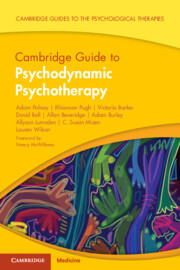Book contents
- Cambridge Guide to Psychodynamic Psychotherapy
- Cambridge Guides to the Psychological Therapies
- Reviews
- Cambridge Guide to Psychodynamic Psychotherapy
- Copyright page
- Dedication
- Contents
- Foreword
- Preface
- A Note from the Series Editor
- Acknowledgements
- Part 1: An Overview of the Model
- Part 2: The Model of Psychodynamic Psychotherapy into Practice
- Chapter 5 Framing a Psychodynamic Space
- Chapter 6 The Goals of Psychodynamic Psychotherapy
- Chapter 7 Psychodynamic Psychotherapy Technique
- Chapter 8 The Overall Structure of Psychodynamic Therapy
- Chapter 9 Psychological Assessment and Formulation in Psychodynamic Psychotherapy
- Chapter 10 Some Reflections on the Supervisory Process
- Part 3: Application for Mental Health Presentations
- Part 4: Application of Psychodynamic Psychotherapy in Different Populations and in Different Settings
- Glossary of Terms
- Index
- References
Chapter 5 - Framing a Psychodynamic Space
from Part 2: - The Model of Psychodynamic Psychotherapy into Practice
Published online by Cambridge University Press: 25 August 2023
- Cambridge Guide to Psychodynamic Psychotherapy
- Cambridge Guides to the Psychological Therapies
- Reviews
- Cambridge Guide to Psychodynamic Psychotherapy
- Copyright page
- Dedication
- Contents
- Foreword
- Preface
- A Note from the Series Editor
- Acknowledgements
- Part 1: An Overview of the Model
- Part 2: The Model of Psychodynamic Psychotherapy into Practice
- Chapter 5 Framing a Psychodynamic Space
- Chapter 6 The Goals of Psychodynamic Psychotherapy
- Chapter 7 Psychodynamic Psychotherapy Technique
- Chapter 8 The Overall Structure of Psychodynamic Therapy
- Chapter 9 Psychological Assessment and Formulation in Psychodynamic Psychotherapy
- Chapter 10 Some Reflections on the Supervisory Process
- Part 3: Application for Mental Health Presentations
- Part 4: Application of Psychodynamic Psychotherapy in Different Populations and in Different Settings
- Glossary of Terms
- Index
- References
Summary
This chapter focuses on the concept of a framing a psychodynamic space. People come to therapists in various states of mind. Some people have histories of neglect and may carry expectations of something similar happening to them in the clinic. Some may be looking for help with long-term difficulties. Others may be acutely distressed and not know why. How we as clinicians present ourselves and organise the caring environment is crucial for a space to be created – or framed – where something therapeutic can happen in relation to these initial anxieties. The boundaries of therapy are not created with an expectation that the patient will always hold them, but rather that if they are not set out it is impossible to explore what might be behind them being shifted. We examine various considerations that go into framing a psychodynamic space. We also discuss the realistic limits of what therapy can offer, and an impulse that may arise in the therapist to extend themselves beyond what is possible. Finally, we consider the important topic of boundary violations by the therapist.
Keywords
- Type
- Chapter
- Information
- Cambridge Guide to Psychodynamic Psychotherapy , pp. 79 - 88Publisher: Cambridge University PressPrint publication year: 2023



